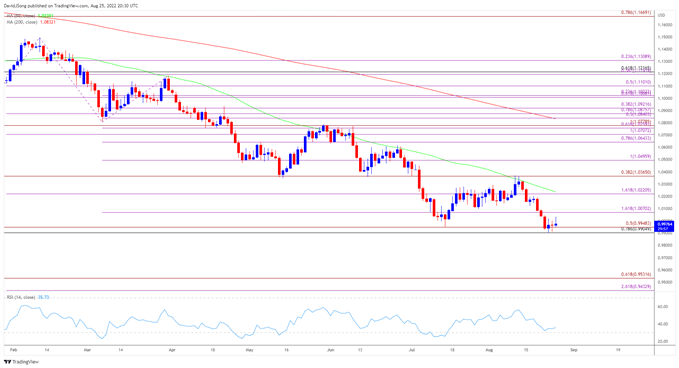EUR/USD Rate Talking Points
The recent selloff in EUR/USD appears to have stalled ahead of the December 2002 low (0.9859) as it snaps the series of lower highs and lows from last week, and the exchange rate may continue to recover over the coming days as the Relative Strength Index (RSI) manages to hold above oversold territory.
EUR/USD Holds Above December 2002 Low to Keep RSI Out of Oversold Zone
EUR/USD seems to be stuck in a narrow range following the limited reaction to the account of the European Central Bank’s (ECB) July meeting, but a break above the weekly high (1.0047) may lead to a larger rebound in the exchange rate as the bearish momentum abates.
Nevertheless, EUR/USD may continue to track the negative slope in the 50-Day SMA (1.0235) even as Governing Council plans to “progress further along the path of policy normalization” as the central bank warns that “there were increasing signs of a downturn in euro area economic activity that could extend into 2023.”
The comments suggest that the ECB will follow a gradual approach in normalizing monetary policy as the central bank sees a “scenario where low growth would itself take care of high inflation,” and it seems as though President Christine Lagarde and Co. will move at a slower pace than its US counterpart as “both market-based measures of inflation compensation and survey-based longer-term inflation expectations were still broadly in line with the Governing Council’s medium-term inflation target.”
As a result, President Lagarde and Co. may implement smaller rate hikes over the coming months as officials insist that “frontloading a 50 basis point increase in July would allow the Governing Council more flexibility in reacting to incoming data,” and the different approach between the ECB and Federal Reserve may continue to drag on EUR/USD as Chairman Jerome Powell and Co. prepare US households and businesses for a restrictive policy.
In turn, EUR/USD may exhibit a bearish trend over the remainder of the year as the former-support zone around May low (1.0349) now acts as resistance, while the recent flip in retail sentiment appears to have been short-lived as traders have been net-long the pair for most of 2022.
The IG Client Sentiment report shows 72.35% of traders are currently net-long EUR/USD, with the ratio of traders long to short standing at 2.62 to 1.
The number of traders net-long is 0.09% lower than yesterday and 15.95% higher from last week, while the number of traders net-short is 0.39% higher than yesterday and 8.89% lower from last week. The rise in net-long interest has fueled the crowding behavior as 71.46% of traders were net-long EUR/USD earlier this week, while the decline in net-short position comes as the exchange rate extends the rebound from the fresh yearly low (0.9900).
With that said, EUR/USD may stage a larger rebound over the coming days amid the failed attempt to test the December 2002 low (0.9859), but the exchange rate may continue to track the negative slope in the 50-Day SMA (1.0235) to largely mirror the price action seen in June.
EUR/USD Rate Daily Chart
Source: Trading View
- EUR/USD appeared to test the December 2002 low (0.9859) after failing to defend the July low (0.9952), but the exchange rate has snapped the series of lower highs and lows from last week amid the lack of momentum to break/close below the Fibonacci overlap around 0.9910 (78.6% retracement) to 0.9950 (50% expansion).
- Need a break/close above the 1.0070 (161.8% expansion) region to bring the 1.0220 (161.8% expansion) area back on the radar, with a move above the 50-Day SMA (1.0235) raising the scope for a test of the monthly high (1.0369) as the Relative Strength Index (RSI) holds above oversold territory.
- However, failure to push above the 1.0070 (161.8% expansion) region may lead to a break/close below the overlap around 0.9910 (78.6% retracement) to 0.9950 (50% expansion), with a break below the December 2002 low (0.9859) opening up the October 2002 low (0.9685).
— Written by David Song, Currency Strategist
Follow me on Twitter at @DavidJSong



Be the first to comment